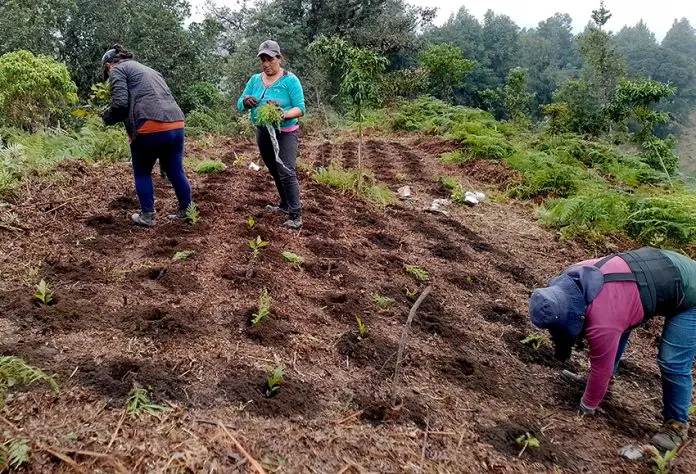In 2000, a cloud forest was unexpectedly discovered at around 1600 meters (5250 ft) altitude in the remote mountains of western Jalisco. The discovery has spurred conservationists into beginning the long work of reforestation in Mexico.
The forest is filled with maple trees, which have been growing alongside giant ferns continuously for the last two million years. Today, it is known as the Bosque de Maple de Talpa. Walking through this luxuriant, steamy, hidden jungle is a truly unforgettable experience.

Could it be possible to turn a parcel of land degraded by logging and agave planting into a vibrant cloud forest like the Bosque de Maple?
“That’s just what I’m hoping for,” says Mexican herbal medicine entrepreneur Leónides Guadarrama, who put his 9.2-hectare tract of land called El Zapotal in Teocelo, Veracruz, into the hands of an organization called Revive Biodiversity Nursery Network in 2020.
Anatomy of a sick forest
Having studied forest regeneration techniques for years — both in Mexico and around the world — the Revive team made a diagnosis of El Zapotal.
“We looked upon this land as a doctor looks at a patient,” Revive Director Aníbal Ramírez told me.
“El Zapotal was in poor shape, nearly treeless, and badly eroded. We began by studying its topography, its orientation, the sunlight it receives, its plants and soil, and, of course, its water flow: Where is water captured? Where are the springs? Sadly, we learned that the output of those springs had dropped 90 to 95 per cent.”

Based on these studies, the team created what they call “key lines” on the slopes of El Zapotal.
Planting trees, Miyawaki style
“These look a bit like the contour lines on a topographical map,” said Ramírez. “Along these lines, we alternate rows of bamboo and low walls of waste material to slow the water as it flows down hillsides and to prevent the soil from washing away…and between the key lines we plant trees, lots of trees, because we are using what is called the Miyawaki method.”
This reforestation approach, developed by Japanese botanist Akira Miyawaki, requires planting up to 15,000 trees of mixed species per hectare, creating the conditions for a dense natural forest to arise within decades rather than the centuries it would usually take.
This labor intensive process requires well-organized specialists. “Our teams,” Ramírez said, “consist mostly of country folk, members of the local community. We currently have about 100 members, highly trained and certified to use the machines needed. After three years, they have learned a lot about the species of plants we use, how to read maps, the whole process. It’s a pleasure to work with people like these who have a well-developed sense of intuition.”

Ramírez told me that most of his team’s members are women.
Women digging holes
“Mexico has some mistaken ideas about this,” said the reforestation expert. “For example, it’s claimed that women can’t operate machines. Well, we are breaking these myths. We train our teams to use machines to dig holes and using [this equipment], some of our compañeras can dig 1,600 or 1,800 holes in a day! Just contrast that with what you can do with a shovel: maybe 120 holes at the very best. So, we are combining technology with traditional wisdom. We think traditions are important, but machines are also marvelous, allowing us to do the work faster and more safely. In fact, in El Zapotal we were able to plant around 57,000 trees within a period of only three months.”
Ramírez and his team call their system Revive Your Spring. Their aim is to recuperate dried up springs and even generate springs in places where there were none before.
Forests that create water
“When you consider that the most important resource we have in this world is water,” explained Ramírez, “it’s surprising how little interest there is in financing the recuperation of water. There is financing for sequestering carbon, for building dams and aquifers, but not for producing water. Here in Mexico there is little recognition of the fact that other countries like France, Canada, the USA and Great Britain began to protect their forests 200 years ago. They said, ‘Okay, we have areas for agriculture and urban development, but areas designated as forests we are not going to touch because forests produce water. These areas will remain forests forever.’

“A natural forest starts producing more water than it needs after maybe 20 years, and then we get the benefit, but here in Mexico, unfortunately, we were thinking of our forests merely as tree plantations. We planted lots of pine trees, for example, but they never produce water because the trees are cut down after 10 years. The water — all of it — goes into the trees! We are, in fact, exchanging water for carbon, for wood. This is what’s happening in Mexico. We have dams and aquifers, but water production itself is in serious trouble.”
Revive Your Spring leads reforestation in Mexico
The Revive Your Spring program hopes to change all this by turning degraded land into cloud forests.
“When we find landowners who accept our proposal,” says Ramírez, “we make it clear to them that once we finish, that land is going to remain a forest forever. So this will not be a source of lumber or other products: just water.”
One such landowner is Leonides Guadarrama who is delighted with the transformation of El Zapotal. He sums up his feelings about Revive’s reforestation projects in one sentence:
“We simply have to give back to nature what we are taking away from her.”
Want to watch a rain forest grow up outside your window? Call Revive!
John Pint has lived near Guadalajara, Jalisco, for more than 30 years and is the author of A Guide to West Mexico’s Guachimontones and Surrounding Area and co-author of Outdoors in Western Mexico. More of his writing can be found on his website.
